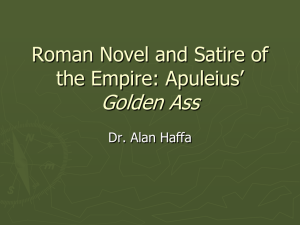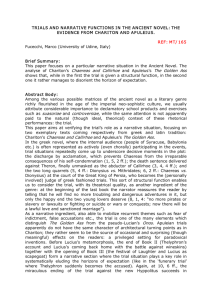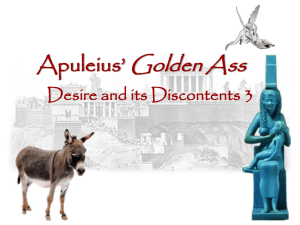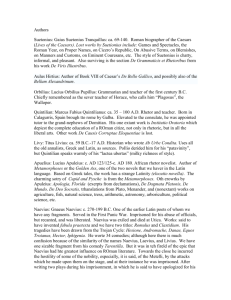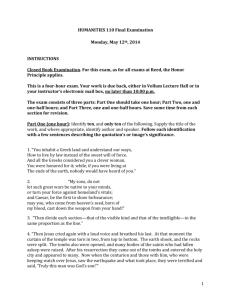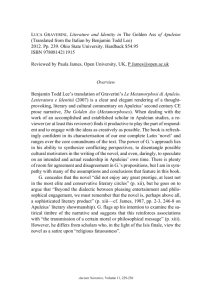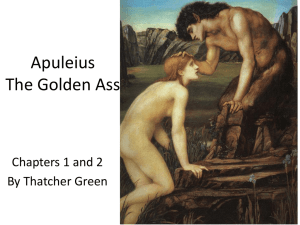Initiations and Mysteries in Apuleius' Metamorphoses
advertisement
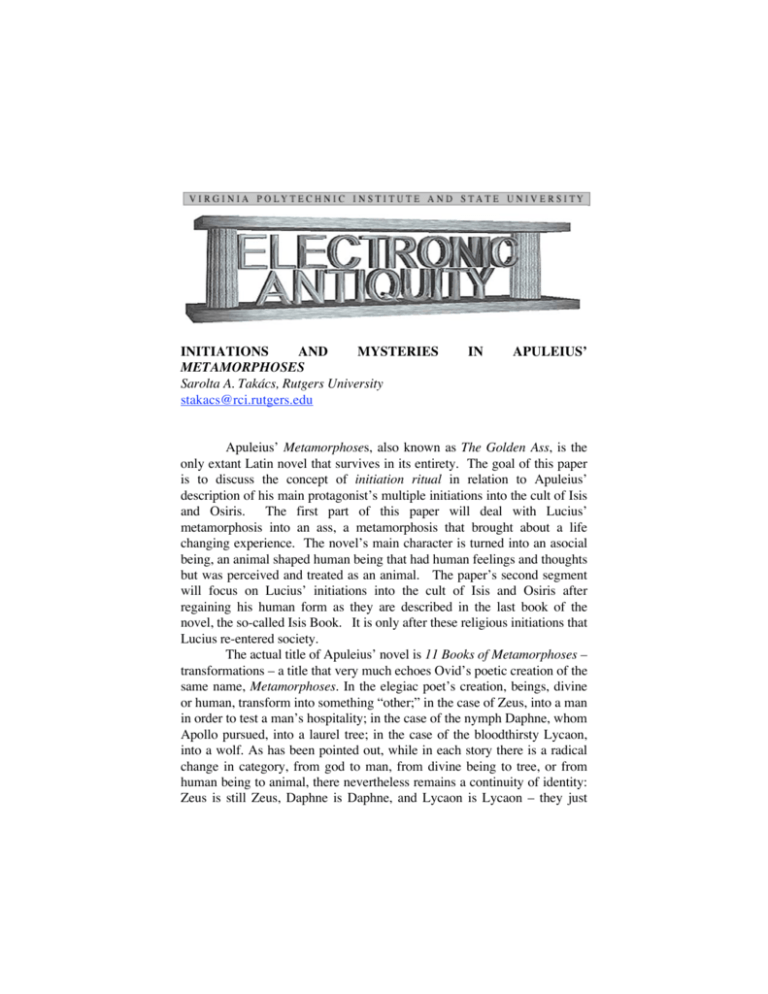
INITIATIONS AND MYSTERIES METAMORPHOSES Sarolta A. Takács, Rutgers University stakacs@rci.rutgers.edu IN APULEIUS’ Apuleius’ Metamorphoses, also known as The Golden Ass, is the only extant Latin novel that survives in its entirety. The goal of this paper is to discuss the concept of initiation ritual in relation to Apuleius’ description of his main protagonist’s multiple initiations into the cult of Isis and Osiris. The first part of this paper will deal with Lucius’ metamorphosis into an ass, a metamorphosis that brought about a life changing experience. The novel’s main character is turned into an asocial being, an animal shaped human being that had human feelings and thoughts but was perceived and treated as an animal. The paper’s second segment will focus on Lucius’ initiations into the cult of Isis and Osiris after regaining his human form as they are described in the last book of the novel, the so-called Isis Book. It is only after these religious initiations that Lucius re-entered society. The actual title of Apuleius’ novel is 11 Books of Metamorphoses – transformations – a title that very much echoes Ovid’s poetic creation of the same name, Metamorphoses. In the elegiac poet’s creation, beings, divine or human, transform into something “other;” in the case of Zeus, into a man in order to test a man’s hospitality; in the case of the nymph Daphne, whom Apollo pursued, into a laurel tree; in the case of the bloodthirsty Lycaon, into a wolf. As has been pointed out, while in each story there is a radical change in category, from god to man, from divine being to tree, or from human being to animal, there nevertheless remains a continuity of identity: Zeus is still Zeus, Daphne is Daphne, and Lycaon is Lycaon – they just 74 Electronic Antiquity 12.1 look different.1 While each one of the protagonists changed his or her outward appearance, the core of their being, the inside, remained unchanged. Ovid’s Metamorphoses are stories (myths) that speak of boundary breakdowns and category changes that, at the same time, also explore liminal situations. At the core of these breakdowns and changes lies an understanding of social and natural organizations. As accepted norms, they remain unchanged. One can move in and out of these organizations and structures while one explores, or is forced to explore, who and what one is, or where one belongs. At the end of any explorative process, however, one returns to the normative, a category or an organization, that provides selfdefinition. In that lies safety and stability. “[E]fforts to establish harsh moral codes and rigid boundaries are futile because the greater the effort to “keep nature and life in place,” the more powerful the forces that dissolve the distinctions between them.”2 Ovid, as scholars have pointed out, indirectly but pointedly criticized Augustus’ policies that aimed at such rigid moral code enforcements.3 Leaving potential political meaning aside, it can also be argued that while Ovid’s entertaining stories emphasize the emergence of “the other,” they also highlight the importance of keeping social and natural distinctions intact. It does not pay off to move outside one’s boundary, and one is better off staying within what is socially and naturally delineated. Like its poetic predecessor, Apuleius’ prose Metamorphoses focuses on the liminal and on the breakdown of boundaries. The leading story is that of Lucius, whose interest in magic backfired and left him in the form of an ass. Untrained in magic skills, he misunderstood and misapplied a formula. Inside the ass-shape, however, remained the cognizant and thinking (human) Lucius, who had to endure the plight of an ass until the goddess Isis appeared to him and revealed how he was to shed his asinine exterior. Apuleius’ masterpiece is filled with literary references, intertextual plays, with social commentaries and philosophical explorations, some more obvious than others. Jack Winkler noted that “misunderstanding a story is Apuleius’ favorite comic subject and its varieties the most significant set of jokes in the novel.”4 What Winkler does not mention, however, is that a misunderstanding of facts does not necessarily lead to an incorrect 1 Olmsted 1996: 168. Olmsted 1996: 171. 3 See Olmsted 1996: n. 19 for bibliographical references on this topic. 4 Winkler 1985: 27. 2 Takács Apuleius’ Metamorphoses 75 conclusion. Things (animal, vegetable, and mineral) are what they are, but our perception of them depends on questions, premises, and interpretations. The former affords stability, the latter flux. This dichotomy permeates the whole novel. When the human Lucius and his host Milo discuss whether higher powers and divine intervention exist or not, Lucius reports that a Chaldean at Corinth5 “is causing disturbance with his remarkable responses. For a small fee he makes public the secret decrees of the fates (2.11).”6 While this soothsayer apparently gives good and sound advice (when to get married, when to travel, etc.), he creates “disturbance,” for his predictions upset the established order, in other words, what had been accepted as reality. Certainly, any attempt to predict the future is mere speculation, but the very act of inquiring about what is to come gives the comforting illusion of safety and control. Roman law dealt harshly with those who claimed to foresee future events that disturbed the socio-political status quo, especially those that threatened the emperor. In retrospect, the Chaldean’s prediction that Lucius’ “fame would blossom considerably” and that his journey will be “the subject of a lengthy story, an unbelievable tale spread over several books,”7 is true within and outside the novel; i.e., within the reality of the novel and, outside of it, the biographical reality of the author. Lucius Apuleius was a famous orator and Platonic philosopher (outside the story) and the Lucius-turned-ass story is told in 11 books (inside the novel). What we deemed “true” just now, however, the fictional character Milo undermines. He pointed out to his guest Lucius that prophesying was a business, but that the Chaldean, whom he knew by name, exhibited no business sense. While the Chaldean was involved in telling his Odyssean travel story to a friend, he lost a rich customer who tired of waiting. And worse, he could not even predict a propitious time for his own travel! In general, the more vague the prediction, the more room there is for interpretation, and thus the chances of accuracy increase. This Corinthian prophet failed by attempting to predict an exact time, which of course, he could hardly have done, except by chance. Depending on chance does not provide stability, precisely what an astrologer, diviner or prophet is asked to impart. 5 Chaldaeans were known as prophets. Met. 2.12: “Chaldeus quidam hospes miris totam civitatem responses turbulenta<t> et arc[h]ana fatorum stipibus emerendis edicit in vulgum...” 7 Met. 2.12: “historiam magnam et incredundam fabulam et libros...” 6 76 Electronic Antiquity 12.1 But if one were to seek stability, where would one have to look? Does stability lie in the recognition of the fact that human life is a continuous set of hits and misses? That some misfortune might actually turn out to be a watershed moment that is the starting point of something positive? Whatever the change, we will remain at the core the same person. In terms of the metamorphosis under consideration here, the shedding of human form and the transformation into an ass is Lucius’ punishment for his curiosity, since he overstepped his boundaries. Having observed Milo’s wife, a witch, Lucius thought he knew how to change himself into an owl and then back again into a human. He was eager to shed his human shape. In the second book Apuleius introduces the story of the hunter Actaeon who chanced upon the bathing Diana in a forest. This was a liminal space, outside the city, the organized and the safe, where potential danger lurked. In this perilous location, Actaeon unknowingly overstepped a boundary when he saw the virgin goddess of the hunt naked. Divine punishment came swiftly; Actaeon was turned into a stag, only to be ripped apart by his own hounds. Lucius confused perception with knowledge. He overstepped a boundary as well in arrogantly thinking he could shape shift without any formal training in magic. Though he was in the right area, Thessaly, the locus classicus for witches and black magic, he lacked skills and knowledge of the appropriate formula and action. He had simply observed the witch uttering a spell and rubbing an ointment on herself that turned her into an owl and then into a human again. The story of Lucius and that of Actaeon correlate and yet remain distinct. Both chance upon the power that can bring about change in a space outside civilization, outside what is safe, and both are punished for their trespass by being turned into an animal. Apuleius introduces an ekphrasis of an intricate marble sculpture that represents Actaeon’s metamorphosis into a stag. His description embodies the perfect myth of overstepping a boundary while also foreshadowing Lucius’ own transformation into an animal. It also encapsulates what “metamorphosis” is all about: the shifting from one category or state into another while, at the very moment of the shift, the original as well as the end form coexist. [2.4] Atria longe pulcherrima columnis quadrifariam per singulos angulos stantibus attolerabant statuas, palmaris deae facies, quae pinnis explicitis sine gressu pilae volubilis instabile vestigium plantis roscidis detinentes nec ut maneant inhaerent<es> etiam volare creduntur. Ecce lapis Parius in Takács Apuleius’ Metamorphoses 77 Dianam factus tenet libratam totius loci medietatem, signum perfecte luculentum, veste reflatum, procursu vegetum, introeuntibus obvium et maiestate numinis venerabile; canes utrimquesecus deae latera muniunt, qui canes et ipsi lapis errant; Hi<s> oculi minantur, aures rigent, nares hiant, ora saeviunt, et sicunde de proximo latratus ingruerit, eum putabis de faucibus lapidis exire, et, in quo summum specimen operae fabrilis egregius ille signifex prodidit, sublatis canibus in pectus arduis pedes imi resistunt, currunt priores. pone tergum deae saxum insurgit in speluncae modum muscis et herbis et foliis et virgulis et alicubi pampinis et arbusculis alibi de lapide florentibus. splendet intus umbra signi de nitore lapidis. sub extrema saxi margine poma et uvae faberrime politae dependent, quas ars aemula naturae veritati similes explicuit. putes ad cibum inde quaedam, cum mustulentus autumnus maturum colorem adflaverit, posse decerpi, et, si fonte<m>, qui deae vestigio discurrens in lenem vibratur undam, pronus aspexeris, credes illos ut rure pendentes racemos inter cetera veritatis nec agitationis officio carere. inter medias frondes lapidis Actaeon simulacrum curioso optutu in deam [sum] proiectus iam in cervum ferinus et in saxo simul et in fronte loturam Dianam opperiens visitur. [2.5] Dum haec identidem rimabundus eximie delector, “tua sunt,” ait Byrrena “cuncta quae vides,…” Pillars stood at each corner, supporting statues representing the goddess Victory. In these representations, her wings were outspread but motionless, and her dewy feet stood on tiptoe on the slippery surface of a revolving sphere, momentarily joined to it but giving the impression of imminent flight. … Hounds … escorted the goddess (Diana) on both flanks. Their eyes were threatening, their ears picked up, their nostrils flaring, their maws savage. If barking sounded loudly from anywhere near at hand, you would think that it issued from those mouths of marble. But the highest feat of craftsmanship achieved by that genius of a sculptor was that the hounds were rearing breast-high, and their hind legs were braking while their forelegs were in rapid motion. … Apples and grapes hung from the lower 78 Electronic Antiquity 12.1 edge of the rock; their highly artistic finish, depicted with a skill rivaling nature’s, made them lifelike … If you bent low and gazed into the water which skirted the goddess’ feet as it lapped into gentle waves, you would think that the bunches of grapes hanging from the rock possessed the faculty of movement as well as other lifelike qualities. In the middle of the foliage a statue of Actaeon was visible, fashioned in marble and reflected in the water; … he was already animallike, on the point of becoming a stag as he waited for Diana to take her bath. … (2.5) As I repeatedly ran my eye over this scene with intense delight, Byrrhena (Lucius’ aunt) remarked: “All this which you see will be yours.”8 The passage is filled with easily identifiable contrasts and opposites on a verbal, as well as a thematic, level: outspread wings :: motionless, joined :: imminent flight, braking :: rapid motion, and life like :: animal-like; god :: human; nature :: reproduction; to see :: to be seen; Lucius’ present is set against his future reality, which reverberates in Actaeon’s transformation but is still unknown to the first-time reader, despite Byrrhena’s remark: “All this which you see will be yours.” Lucius takes in the scene with intense delight (eximie delector); the scene, nevertheless, with all its bucolic beauty, depicts hounds in a heightened state of attack, who will tear curious Actaeon (Actaeon curioso) apart. Of course, to take delight is exactly what Apuleius instructs us, the reader, to do in the very beginning of his novel (lector intende: laetaberis). Like Actaeon, Lucius is curious and his curiosity led him astray into unsafe, liminal space. Lucius stressed in the beginning of this adventure that he was “not curious but the type who likes to know about everything, or at least about most things.”9 And, just as Actaeon, the uninvited viewer, was dealt with fiercely by Diana and changed into a stag, Lucius, in a stupor (3.22: in stupore), dabbling in magic, is changed into the shape of an ass. Thus, the stage is set for adventures and learning experiences. It is in this “other” state (as a human with the body of an ass) that Lucius learned that above all he wanted to be human! He had to reach the ultimate point, though, where he simply wanted nothing more than death, for he could no longer endure being a maltreated animal with a human mind. It is at this moment that the goddess Isis entered his 8 9 Translation Walsh 1994. 1.2: “non quidem curiosum, sed qui velim scire vel cuncta vel certe plurima...” Takács Apuleius’ Metamorphoses 79 life. Lucius will be returned to his human form, become an initiate into the cult of Isis and Osiris, and lead a successful professional life. The last book of the novel, Book 11, is all about initiation. Lucius moves across two boundaries or conditions: that of animal to human, and then, from an uninitiated to an initiated state. We could say that in the first state he was an asocial being, to whom the social rules of human society did not apply. Although the narrative as entertainment continuously introduces the ass to human situations, this does not make the ass a social being. Lucius, the ass, had to endure being a lowly, despised animal, which no human understands. He was utterly the Other. Even in the Egyptian pantheon this was the case for the ass. Seth, the ass-shaped god, was the deadly adversary of Osiris and Isis, the life­ giver. Seth murdered his brother Osiris and chopped him up into pieces, which he scattered across Egypt. Isis, the sister and wife of Osiris, lamented her husband’s death and sought the pieces.10 She found all but one, the phallus, and mended the pieces together, completing the body with an artificial organ. Isis then had intercourse with her dead, mended husband-brother and conceived a son, Horus, who, like his father, had to fight Seth. Osiris was a god who, although lifeless, had procreative force. This inversion is quite common in fertility myths. Fecundity resides in the opposite – that which seems most barren. What does Apuleius’ focus on initiation mean? Merkelbach suggested that all ancient novels are to be decoded as mystery initiations. Lucius’ struggle was from the beginning meant to culminate in Isiac worship, and has the quality of propaganda. All the deities and affairs related throughout the piece point to Isis in one of her multiple forms or expressions. In matter of fact, Lucius Apuleius the author was an Isiac and as such must have been interested in converting others. Since the cult of Isis prepared the world for Christianity, worshippers of the henotheistic Isis must have done the same. This explanatory model ignores the fact that conversion was not something pagan cults pursued. The pagan worldview was polytheistic and open, and allowed the coexistence of gods and their respective worship. There was not one true God, no dogmas and thus no need to subject oneself to a single entity or an ideological system. In his 1995 book, Münstermann asked in a tone that seems incredulous: “How could Apuleius bring his philosophical conviction 10 Her tears were thought to have created the life-giving Nile. 80 Electronic Antiquity 12.1 modeled after Plato in accordance with his Isisglauben11?” Even if Apuleius had been interested in, or even initiated into, the cult of Isis, it would not have interfered with his interest in Platonic philosophy. Apuleius states in a different work that he participated with great zeal in many cults, rites, and ceremonies.12 Münstermann’s question reflects a long-held scholarly error that the cult of Isis attracted only members of the demi-monde, the degenerates of Roman society. This would make it impossible for a rational thinker like the philosophus Platonicus Apuleius to have been an initiate. Unfortunately, old explanatory models die too slowly! The fact is that in the lifetime of Apuleius the cult had been officially accepted and linked to the imperial household, the domus Augusta, for almost a century. Further, the reigns of Hadrian and Marcus Aurelius, beginning and end markers of Apuleius’ life, saw particular intensification of interest in Egypt and its gods. It is in the description of the final initiation (Book 11. 27) that Lucius Apuleius reveals himself and leaves the reader to wonder whether what has been told so far as a fiction was actually true.13 This is simply another transformation, maybe the best one so far – the auctor being the actor, the actor being the auctor. Griffiths proposes that toward the end of the book which deals with Lucius’ initiation there is “the bestowal of salus [well-being], a deliverance both physical and spiritual, on the asinine Lucius through the grace and 11 Münstermann 1995: 130: "Wie [kann] Apuleius seine in erklärter Anlehnung an Platon formulierte philosophische Überzeugung mit dem Isisglauben vereinbar[en]?" 12 Apol. 554: “multiiuga sacra et plurimos ritus et varias cerimonias studio veri et officio erga deos dedici.” 13 A good discussion on history and fiction in Book 11 is Riess 2001: 362-365. In 1989, F. Coarelli discovered a dwelling complex in the vicinity of the North African cooperation in Ostia. Two water pipes were found there with the inscription: “Lucius Apuleius Marcellus” and the base of an equestrian statue with a dedication honoring the consul Quintus Asinius Marcellus. The complex included a mithraeum with depictions of the seven cosmic spheres, which very much coincides with Apuleius’ description of the cosmos in his philosophical writings (Riess 1992: 338). Apuleius named the priest who initiated his protagonist Lucius into the cult of Osiris Asinius Marcellus. As often happens in this novel, reality and fiction intersect. The Asinii Marcelli were a prominent Roman family in the second century CE and the author of the novel shares the same first name as his main protagonist, Lucius. The archaeological find moves the narrative fiction into autobiographical reality. These kinds of intersections (fiction/reality or perception/knowledge) compose the novel’s narrative dynamic. Takács Apuleius’ Metamorphoses 81 loving mercy of Isis.”14 I agree, however, with Schlam that the Metamorphoses is not an account of a growing religious consciousness, not a work of religious confession.15 Sandy also showed successfully that Isis’ intervention in Book Eleven is “the moral complement of the first three books rather than the narrative safety-valve analogous to the contrived religious conclusions of some of the picaresque romances.”16 Further, in his assessment “Book 11 has redeeming qualities of its own. It firmly anchors Lucius’ restless obsession to experience the supernatural in Isis’ portus Quietis. … [the goddess] led him out of the hopeless labyrinth.”17 I will now focus on this detailed description of how Isis led Lucius out of this labyrinth. The ass, destined to have intercourse with a female criminal in an amphitheater, decides to escape his captors. In a state of emotional upheaval and fearing for his well-being (de salute ipsa sollicitus),18 Lucius galloped six miles at utmost speed to Cenchreae, a Corinthian colony on the Saronic gulf, known for its harbor that granted safest refuge for ships, and which now granted a safe haven for the escapee. There, Lucius the ass collapsed on the beach and sweet sleep came over him (dulcis somnus). The tone at the end of the tenth book is set: a safe place and sweet sleep clue the reader into the strong possibility of Lucius’ deliverance from the ass’ shape. Safety and calm, however, is replaced with opposites at the onset of Book Eleven. It starts with the ass’ sudden terror-stricken awakening (experrectus pavore) and his perception of the full moon, in all its light, appearing through the waves of the sea (subito video praemicantis lunae candore nimio completum orbem commodum marinis emergentem fluctibus). Lucius seems to experience photism, a hallucinatory or pseudo­ hallucinatory luminous phenomenon, known as the prelude to intense religious experiences. Lucius the ass was aware that he was to acquire the silent secrets of the shadowy night (opacae noctis silentiosa secreta) from “the supreme goddess who wields her power with exceeding majesty” and “that human affairs were controlled wholly by her providence (summatem deam praecipua maiestate pollere resque prorsus humanas ipsius regi providential).” Exalted and eager, Lucius jumped into the sea to purify himself (alacer exurgo meque protinus purificandi 14 Griffiths 1978: 153. Schlam 1978: 124. 16 Sandy 1978: 124. 17 ibid., 137. See also Shumate 1996: 285-328. 18 Met. 10.35. 15 82 Electronic Antiquity 12.1 studio marino lavacro). He submerged his head seven times beneath the waves – a number especially apt for religious rites (praecipue religionibus aptissimum). Thus purified, Lucius began to pray to the all-powerful goddess (deam praepotentem), queen of heaven (regina caeli), amidst cries and lamentations. His prayer was traditional; if one is not sure who the deity is, then try to cover all bases, and ask for whatever help is needed. Although Lucius addressed the moon, he also uttered: “you appear as Ceres, bountiful and primeval bearer of crops, or celestial Venus, or the sister of Phoebus, or … the horrid Proserpine (siue tu Ceres alma frugum parens originalis, seu tu caelestis Uenus, seu Phoebi soror, seu ... horrenda Proserpina), and toward the end “but by whatever name or rite or image it is right to invoke you (quoquo nomine, quoquo ritu, quaque facie te fas est invocare)” indicating that he is already thinking of Isis19. Lucius’ request is: [11.2] sit satis laborum, sit satis periculorum. Depelle quadripedis diram faciem, redde me conspectui meorum, redde me meo Lucio. Ac si quo offensum numen inexorabili me saevitia premit, mori saltem liceat, si non licet vivere. Let this be enough toils and enough dangers; rid me of this dire, four-footed form. Restore me to the sight of my family; restore me to my Lucius. But if I have offended some divinity who continues to oppress me with implacable savagery, at least allow me to die, since I cannot continue to live. Tested and having reached his breaking point – he would rather die than continue to live – Lucius was ready to be himself again and join his family. He was more than ready to re-enter society. After this, sleep enveloped and overcame Lucius. And, in his sleep, Isis appeared. Apuleius’ ekphrasis runs over two paragraphs (11.3-4) before the goddess revealed herself in an aretology, the only one of Isis we have in Latin: [11.5] rerum naturae parens, elementorum omnium domina, saeculorum progenies initialis … et qui nascentis dei Solis inchoantibus inlustrantur radiis Aethiopes utrique priscaque 19 Griffiths 1978: 115-118 for discussion of the identification of Selene with Demeter, the designation of the moon as the eye of Artemis, as Proserpina/Hekate, and its resemblance to Aphrodite, also noted in Plut. Amat. 19, 764D. Takács Apuleius’ Metamorphoses 83 doctrina pollentes Aegyptii caerimoniis me percolentes appellant vero nomine reginam Isidem. properii I am the progenitor of nature, mistress of all elements, first­ born of generations … the peoples on whom the rising sun shines its rays, both Aethiopians and the Aegyptians who gain strength by ancient doctrine, worship me with the appropriate ceremonies, call me by my right name, queen Isis. Then, Lucius receives exact instructions how he is to shed his animal skin (11.5-6). He is to eat roses held by one of Isis’ priests at the procession of the navigium Isidis, the festival that opened the sailing season in March. You are to await this rite with an untroubled and reverent mind (11.5). … What you must carefully remember and keep ever locked deep in your heart is that the remaining course of your life until the moment of your last breath is pledged to me, for it is only right that all your future days should be devoted to me, to the one whose kindness has restored you to the company of men. Your future life will be blessed, and under my protection will bring you fame; and when you have lived out your life’s span and you journey to the realm of the dead, even there … you will constantly adore me, for I shall be gracious to you … (11.6, Walsh 1994) After Isis’ prophecy, Lucius the ass woke up. “With mingled emotions of fear and joy I arose, very much in sweat, utterly amazed by so clear presence of the powerful goddess (pavore et gaudio ac dein sudore nimio permixtus exurgo summeque miratus deae potentis tam claram praesentiam …11.7). Lucius then washed himself with seawater and noted that nature is joyfully awakening to a new season. Nature’s awakening, the coming of the spring, is set parallel to that of the ass’ imminent transformation, Lucius’ return to human society. At this point, still in a highly sensate state, his emotions are mixed: inwardly, he feels fear and joy; outside, he perspires. Once returned to human shape, he fell silent feeling only joy (11.14). Despite his inability to speak, unlike the speechless ass-formed Lucius of the previous books, this Lucius IS human inside and out! 84 Electronic Antiquity 12.1 The human Lucius will go through three initiation rites in the cult of Isis and Osiris, but none of Apuleius’ descriptions offers the same emotional detail as the metamorphosis from ass to human. The often cited Reginald Witt stated that “[f]rom the pages of Apuleius we can gain much invaluable knowledge of the main features of Isiac initiation as it was practiced in the imperial age (Isis in the Ancient World, 1997.158).” Indeed, the text offers “invaluable knowledge” but none about the mystery. The knowledge we gain is about public actions such as 1) the procession of the setting out of a model ship to inaugurate the opening of the sailing season on March 5 (the navigium Isidis) and 2) the subsequent ceremony in the temple of Isis. We learn that Isiacs wore white dresses,20 women wore the headdress and men had clean shaven heads.21 Women, crowned with flowers, led the procession,22 initiates without special cultic duties formed the middle, and various priests, each carrying a specific symbol of the cult23, closed the procession train. After the launching of the ship, the chief priests entered the inner sanctuary of the temple and set up the “living statues.” A scribe standing before the entrance summoned the pastophori and then recited, from a book, formulaic prayers for the well-being of the emperor, the state as a whole, and seafarers. Then in Greek (one assumes 20 amicimina or linteamina candida. Met. 11.10: “illae limpido tegmine crines madidos obuolutae, hi capillum derasi funditus uertice praenitentes.” 22 Met. 11.9: “inter has oblectationes laudicras popularium, quae passim uagabantur, iam sospitatricis deae pecularis pompa moliebatur: mulieres candido splendentes amicimine, uario laetanes gestamine, uerno florentes coronamine, quae de gremio per uiam, quae sacer incedebat comitatus, solum sternebant flosculis (...).” 23 From Apuleius' account (Met. 11.10-1) we can deduce that a cultic association had at least five antistetes, who in the hierarchy were placed below the sacerdos. These five carried various insignia of Isis in a procession; namely, 1) a cup-shaped lamp (lucerna consimilis cymbium), 2) a portable altar (altaria), 3) a palm tree with golden leaves and a caduceus (palma auro foliata, Mercuriale caduceum), 4) a model of a streched out left hand (manus sinistra porrecta palmula) and a golden vessel in the shape of a nipple (aureum uasculum in modum papillae), and 4) a golden winnowing-basket (aurea uannus). Whether the person wearing the mask of Anubis or the three men carrying 1) a statue of a cow on his shoulders (bos in erectum leuata statum (...) quod residens umeris suis), 2) a roomy chest containing secrets (cista secretorum capax), and 3) the venerable effigy of the highest divinity (summi numinis uneranda effigies) were also called antistetes we do not know. It certainly is possible. It is clear, however, that the sacerdos held the highest cultic position. In his right hand he carried a rattle (sistrum) and a garland (corona). 21 Takács Apuleius’ Metamorphoses 85 that previously the scribe spoke Latin), he announced the launching of the ships (11.17). The crowd then brought boughs, branches and garlands, and after kissing the feet of a silver statue of Isis attached to the temple-steps, they went home (11.17). We are also offered a description of the morning opening ceremony of a temple of Isis (11.20) and learn that “the act of initiation itself was performed as a rite of voluntary death and of salvation attained by prayer (11.21).” There was a preparatory period when Lucius took up quarters in the temple precinct and had visions of the goddess every night. Once a person was deemed ready, we learn, s/he was instructed after the morning ceremony and informed which preparations were necessary. The books, which contained this information, seemed to have been written in hieroglyphs (11.22). The person to be initiated had to bathe and then was sprinkled with water by a priest so as to render him/her “purified.” A ten-day period followed during which no meat could be eaten or wine could be drunk. Then, clad in a new linen garment, the initiate was led into the inner sanctuary. Lucius reports: [11.23] Accessi confinium mortis et calcato Proserpinae limine per omnia vectus elementa remeavi, nocte media vidi solem candido coruscantem lumine, deos inferos et deos superos accessi coram et adoravi de proximo I approached the confines of death and trod the threshold of Proserpina, and returning I journeyed through all elements. In the middle of the night I saw the sun gleaming with bright brilliance. I stood in the presence of the gods below and the gods above, and worshipped them from close at hand. Lucius went through two additional initiations, the last into the mysteries of Osiris. As with the first initiation, there was a ten-day period of abstinence and a nocturnal ceremony. After the third initiation, Lucius, his head shaved, becomes a pastophoros in the most ancient college founded at the time of Sulla, a college that was attached to the temple of Isis in the campus Martius. As Isis had promised to Lucius when she appeared to him for the first time (11.6), his life as a devotee was blessed and he would become famous. The novel ends with a final overlap of fiction and reality. The author Lucius Apuleius was indeed famous and on many accounts blessed. The inscriptions from Ostia also confirm an actual link 86 Electronic Antiquity 12.1 between the author and the cult of Isis. He was an initiate.24 But what exactly did Apuleius tell us about the mysteries of Isis and Osiris? Nothing more than what an uninitiated one would know: there was a ritual death and rebirth; at the moment of initiation, all senses were heightened and extraordinary things were perceived; and the divine and the human world collapsed into one. In the case of Lucius the former ass or Lucius Apuleius the author, there was “a journey through all elements, a catching sight of the sun at the dead of night, and ultimately being with gods of the dead (below) and the living (above).” Ultimately, with the proper preparation set forth by the cult, anybody could learn or perceive the secret, the mysterion. More significant than the fact that there was a cultic secret is that people agreed that there was one, which served as separator between those who knew and those who did not. There were the in-group of initiates and the out-group of the uninitiated. Spinning this a bit further, it is possible that we, the outsiders, know this cult’s secret whether intuitively or accidentally acquired, but because we are the uninitiated ones, we could have no way of knowing that we know this. This, I would argue, is what Apuleius tries to explain playfully throughout the novel. The continuous interplay of the known and unknown, the perceived and mis-perceived, gives the novel its multivalent narrative dynamic. While Apuleius entertains his reader, he also accurately and specifically describes the physical and psychological experiences that go hand in hand with initiation. What he leaves unexplained is the exact initiation sequence and the initiation rituals themselves. In this way the boundary between the initiate and the uninitiated remains forever intact. And the mystery surrounding Isis and Osiris remains unknown. 24 Riess 2001: 339-340. Takács Apuleius’ Metamorphoses 87 WORKS CITED Griffiths, J.G. 1978. “Isis in the Metamorphoses of Apuleius.” In B.L. Hijmans, Jr. and R.T. van der Paardt, eds., Aspects of Apuleius’ Golden Ass. Groningen: Bouma’s Boekhuis. Münstermann, H. 1995. Apuleius: Metamorphosen literarische Vorlagen. Stuttgart: B.G. Teubner. Olmsted, W. 1996. “On the Margins of Otherness: Metamorphosis and Identity in Homer, Ovid, Sidney, and Milton.” New Literary History 27 (2): 167-184. Riess, W. 2001. Apuleius und die Räuber. Stuttgart: F. Steiner. Sandy, G.N. “Book 11: Ballast or Anchor.” In B.L. Hijmans, Jr. and R.T. van der Paardt, eds., Aspects of Apuleius’ Golden Ass. Groningen: Bouma’s Boekhuis. Schlam, C. 1978. “The Metamorphoses of Apuleius.” In B.L. Hijmans, Jr. and R.T. van der Paardt, eds., Aspects of Apuleius’ Golden Ass. Groningen: Bouma’s Boekhuis. Shumate, N. 1996. Crisis and Conversion in Apuleius’ Metamorphoses. Ann Arbor: University of Michigan Press. Walsh, P.G. 1994. Apuleius: The Golden Ass: Translated With Introduction and Explanatory Notes. Oxford: Oxford University Press. Winkler, J.J. 1 985. Auctor and Actor. A Narratological Reading of Apuleius’ The Golden Ass. Berkeley: University of California Press.
